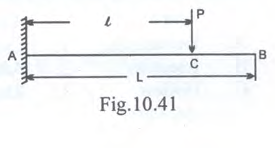Strength of Material Sheet 24
-
1) Question.
Given that for a channel section, the width of flange = , the depth of the web between centres of flanges = , the
thickness of flange = , the moment of inertia = , the distance 'e' of the shear centre outside the channel section from
the mid thickness of the web is
Answer. -
2) Question.
A material of Young's modulus and Poission's ratio is subjected to two principal stress and at a point in a
two-dimensional stress system. The strain energy per unit volume of the material is
Answer. -
3) Question.
The state of stresses on an element is shown in the Fig. 10.49. The values of stresses are
and major principal stress
Answer. -
4) Question.
The rectangular block shown in Fig. 10.48 is subjected to pure shear of intensity .

If represents the principal plane and the principal stresses are then the values of
Answer. -
5) Question.
A cylindrical bar of diameter and length is subjected to a tensile test. Its longitudinal strain is times that
of its lateral strain. If the modulus of elasticity is then its modulus of rigidity will be&n
Answer. -
6) Question.
If a member is subjected to tensile stress of , compressive stress of and tensile stress of along the
directions respectively, then the resultant strain
Answer. -
7) Question.
At a point in a steel member, the major principal stress is (tensile) and the minor principal stress is
compressive. If the uniaxial tensile yield stress is, then accroding to the maximum shear stress theory, the
magnitude of the minor principal stress (compressive) at which yielding will commence is
Answer. -
8) Question.
The rectangular column shown in Fig. 10.47 carries a load having eccentricity and along the x-axis and y-axis respectively.

The stress at any point (x,y) is given by
Answer. -
9) Question.
A thin cylindrical shell of internal diameter and thickness is subjected to internal pressure . The change in
diameter is given by
Answer. -
10) Question.
If the strain energy absorbed in a cantilever beam in bending under its own weight is times greater than the strain
energy absorbed in an identical simply supported beam in bending under its own weight, then the magnitude of is
Answer. -
11) Question.
If the diameter of a shaft subjected to torque alone is doubled, then the horse power can be increased to
Answer. -
12) Question.
Consider the following statements regarding a beam of uniform cross section simply supported at its ends and carrying a
concentrated load at one of its third points:
A) Its deflection under the load will be maximum.
B) The bending moment under the load will be maximum.
C) The deflection at the mid-point of the span will be maximum.
D) The slope at the nearer support will be maximum.
Of these statements
Answer. -
13) Question.
A simply supported rectangular beam of span and depth carries a central load . The ratio of maximum
deflection to maximum bending stress is
Answer. -
14) Question.
A three hinged semicircular arch of radius carries a uniformly distributed load per unit run over the whole span.
The horizontal thrust is
Answer. -
15) Question.
A short column of external diameter and internal diameter carries an external load . For no-tension condition,
the eccentricity will be
Answer. -
16) Question.
The ratio of the flexural strength of two beams of square cross-section, the first beam being placed with its top and bottom
sides horizontally and the second beam being placed with one diagonal horizontally, is
Answer. -
17) Question.
If the area under the shear curve for a beam between the two points and is then the difference between the
moments at the two points and will be equal to
Answer. -
18) Question.
In a strained body, three principal stresses at a point are denoted by and such that . If
denoted yield stress, then according to the maximum shear stress theory
Answer. -
19) Question.
Two closed thin vessels, one cylindrical and the other spherical with equal internal diameter and wall thickness are
subjected to equal internal fluid pressure. The ratio of hoop stresses in the cylindrical to that of spherical vessels is
Answer. -
20) Question.
A cantilever carries a load at as shown in Fig. 10.41.

The deflection at is
Answer.

